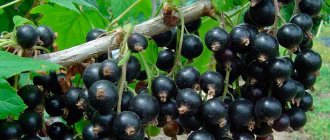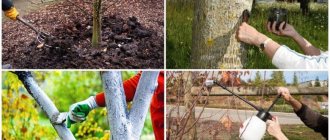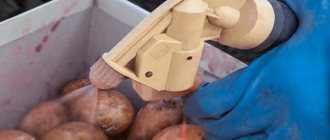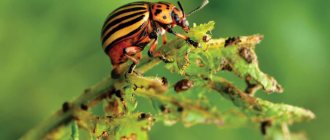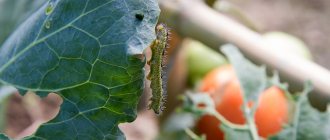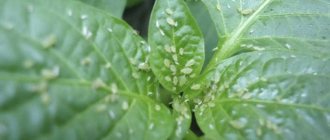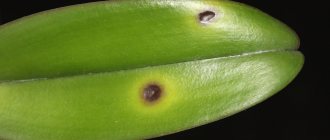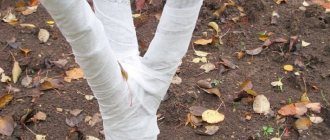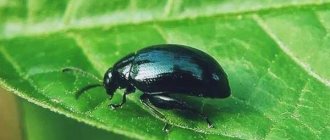The apple orchard, not only in summer, but also in autumn, requires our protection and increased attention. Today we will talk about how to properly treat an apple tree in the fall against diseases and pests, as well as what preparations should be used to treat trees before wintering.
Treatment of apple trees in the fall 1.1 Why treat apple trees before wintering 2. Treating trees against diseases 3. Spraying an apple orchard against pests 4. Preparations for treating apple trees in the fall 4.1 Whitewashing trees
Photo pixabay/MariaGodfrida: It is important to pay attention to the apple tree in the fall.
Indications for treating apple trees in autumn
Caring for apple trees in the fall includes a set of measures aimed at reducing the amount of infection , destroying accumulations of pests overwintering in the garden, as well as increasing the winter hardiness of fruit-bearing plantings.
Ignoring preventive measures at this time of year will lead to massive damage to trees in the spring. Diseases are a leading cause of damage to gardeners. Among the ailments, the most common are those of a fungal nature. Viruses and bacteria infect fruit trees much less frequently. If symptoms of a certain disease or pest appear on the apple tree, treatment must be carried out as soon as possible.
The concentration of drugs and the frequency of treatment largely depend on the climate zone. In the southern regions, trees should be treated more often and stronger solutions should be mixed for this. Pests and pathogens often adapt to specific products. Therefore, it is recommended to periodically change them for others.
The effectiveness of spraying is enhanced if it is combined with other reasonable methods of agricultural technology: disinfection of working tools, elimination of infected leaves and fruits, weeding.
Autumn treatment is required when the following is detected on apple trees:
- Scab is a fungal disease that causes dark brown spots and cracks on fruits and leaves.
- Ulcerative lesions of the cortex.
- Dark spots on tree trunks.
- Lichen.
- Tinder fungi.
In addition to obvious problems, the apple orchard can be threatened by hidden infections such as powdery mildew, brown spot and munilia. In addition, insect pests are already preparing for wintering on trees, which usually hide under the bark, near the buds, inside the branches and in the top layer of soil.
What to do to protect yourself from hidden infections
First of all, powdery mildew can be distinguished here. She likes to overwinter in the apple tree, so the gardener should think about using 1% Bordeaux mixture and a solution of copper sulfate (dilute 50 grams of the solution in a bucket of water), add 20 grams of laundry soap shavings and spray the tree.
Be sure to burn the fallen leaves and treat the crown with Bordeaux mixture to protect the apple tree from the possible development of brown spot in the spring. To destroy moniliosis, collect rotten apples and dig up the ground under the tree.
Processing rules
The phases and rules of autumn processing of apple trees are tied to the stages of the plant’s life cycle. Autumn control of pests and diseases of fruit trees is carried out after the end of the growing season. After leaf fall, the apple orchard can be successfully sprayed with higher concentrations of chemicals without fear of leaving burns.
There are a number of processing rules:
- spraying should be carried out in clear, windless weather;
- the air temperature should be at least 5 degrees Celsius;
- the sprayer should create a uniform cloud of fine suspension;
- any lesions on the bark must be cleaned before treatment and treated with copper sulfate;
- shortly before the start of the procedure, the garden should be cleared of all plant debris.
If no diseases or pests were found on the trees during the warm season, then the residual debris can be taken to the compost pit. Otherwise, it will have to be burned or buried.
Autumn spraying should be as thorough as possible; in this case, not only the crown and trunk of the tree are subject to treatment, but also the soil in the tree trunk circle. But nearby lawn grass should not be treated.
Precautionary measures
To spray trees you will need:
- containers whose material does not react with chemically active substances - glass, plastic;
- sprayer;
- fine sieve or mesh for filtering the solution;
- stirring spatula;
- personal protective equipment: rubber gloves, safety glasses, respirator, long sleeves and trousers that completely cover the skin, closed shoes.
We recommend that you familiarize yourself with the features of treating apple trees against pests and diseases.
Before spraying, remove damaged branches, trim loose areas of bark and remove crop residues from the branches. Rotten fruit on branches is a potential source of fungal spores. For processing, choose a dry, not sunny day. A prerequisite is the absence of wind.
You need to spray it on the branches carefully so as not to get it on yourself or spray the air. Use only fresh mixtures, as some substances react with air and lose their effectiveness after a short period of time. After work, wash all tools with running water. Wash your hands and face thoroughly.
Taking care of apple trees on your property is quite simple. The main thing is not to miss the time for preventive spraying. After all, any disease is cheaper and easier to prevent than to treat.
Preparations for spraying apple trees
To prevent infection of apple trees and insect infestations during autumn treatment, it is very important to dose the preparations correctly and follow the recommended doses. The choice of means of protection depending on the condition of the tree also plays an important role.
These substances are of contact action only. This means that they do not have a cumulative effect, are washed off by rain and do not harm people, animals and dormant apple trees.
- Urea (urea) is white or colorless crystals, soluble in liquid. This substance, at high concentrations, is capable of burning out all fungal and viral infections, and also effectively fights insects overwintering on trees. During autumn treatment, urea simultaneously plays the role of both a fungicide and an insecticide. In addition, urea will increase the winter hardiness of the apple tree.
- Iron sulfate is a concentrated solution of iron used to prevent and treat damage to the branches of fruit trees. It is successfully used to destroy overwintering larvae and fungal diseases.
- Copper sulfate is another effective and inexpensive preventive fungicide used in the fall to prevent diseases of fruit crops. This drug is not recommended to be mixed with Bordeaux mixture or iron sulfate.
- Bordeaux mixture - spraying with it is considered the final stage in the autumn treatment of the garden. Contains copper ions, which kill fungi and bacteria, destroying plant protein.
Answers to frequently asked questions
Is it important how to whiten the trunks of apple trees? Along the trunk or around?
Whitewashing should be carried out strictly vertically from bottom to top, carefully painting the trunk.
What water should I use to prepare solutions of fungicides and insecticides?
To prepare all working solutions, you need to use water at 25-27 ° C, settled or with the addition of a pH neutralizer.
How many times do apple trees need to be treated?
Each treatment requires a certain number of treatments, just as each has a maximum allowed number of treatments per season.
We always treated it with one product, and it did the job perfectly, but it stopped working. What is the problem?
The problem is that infections and pests become accustomed to the effect of the substances, so treatment agents must be alternated.
Means and methods for treating apple trees against diseases
To combat various diseases and pests affecting fruit crops, appropriate methods of prevention and treatment have been developed.
Treatment of moniliosis
This tree disease is caused by fungal spores carried by insects that pollinate the blossoming buds. Under the influence of fruit rot, the branches and foliage of apple trees look scorched. To treat plants for moniliosis, infected parts of the tree are removed and burned. The affected apple tree and the trees adjacent to it are sprayed with antifungal compounds. The following have proven themselves well in this regard:
"Abiga Peak";- "Topsin";
- "Horus";
- "Kuproksat";
- copper sulfate.
Fungus treatment
If untreated cuts or broken branches are found on the apple tree, this indicates that the tree may be infected with mold.
To prevent the development of the disease, damaged areas of the bark should be cleaned with a thick brush, and damaged branches should be trimmed. Treat cleaned areas with fungicides. In addition, it is necessary to whitewash with slaked lime. Treatment will give a positive result only at the beginning of the disease. And after the fungus penetrates the cambium, the entire tree will gradually die.
From lichen and moss
Apple trees are cleaned of lichens and moss only in late autumn. Before processing, the crop must already be harvested and fallen leaves removed from the garden. The branches are treated with a solution of iron sulfate, the effect of which lasts a week. After this period, mosses and lichens are carefully cleaned from the trees. Damaged areas are covered with garden varnish. After another week, it is necessary to repeat the treatment, spraying the ground next to the tree. Complete the cleaning with whitewashing.
Bacterial and viral diseases
Bacterial microorganisms can cause peculiar burns that affect the tissues of the apple tree.
Microbes that enter the tree through damage to the bark accompany moniliosis. The cause of infection can be insects. To combat such diseases, broad-spectrum antibiotics are used. At the same time, insects carry viral diseases, for example: mosaic, witch's broom, star cracking of apples and much more. Once in the wood tissue, viruses become a catalyst for the process of their degeneration into malignant formations.
Currently, there is no specific treatment for viral diseases of apple trees, so it is necessary to destroy identified foci of the disease. Phytohormones are used as prophylaxis.
Gardening Tips and Tricks
- It is more convenient to remove mosses and lichens using wet bark (pour water on it before starting cleaning);
- To whitewash apple tree trunks, you can use sprayers, sponges or brushes (you can tie several brushes together to speed up the process);
- To prepare fungicides, first dilute the product in a small amount of water and then bring it to the required volume;
- To fully treat frostbitten areas of a tree, you can apply a fabric bandage to the wound, and on top of it a mixture of clay and mullein.
How and how to treat an apple tree against pests
Apple tree pests are divided into three groups:
- insects;
- mites;
- rodents.
Treatment of apple trees from their harmful presence is carried out taking into account their numbers and species characteristics. In the fall, the procedure is carried out without fail.
Insects
To combat insects, urea is considered the best preventative treatment. Spraying it is carried out on a regular basis. In addition, industrial preparations of the insecticidal group are used to destroy insect pests.
Ticks
Spider mites are one of the most harmful phenomena for an apple orchard. Universal acaricidal-insecticidal preparations are effective against these pests. Treatment should be carried out not only in autumn, but also in spring, before and after flowering. It is important to complete processing before the ovary forms.
Rodents
Mice, hares, wild rabbits and water voles pose a serious threat to apple trees in winter - they are capable of chewing off a circular strip of bark and interrupting the circulation of vital tree juices. In addition to mechanical protection, the wood will need to be treated with a protective compound. For this purpose, spraying with copper sulfate or Bordeaux mixture is used.
How is autumn whitewashing carried out?
Whitewashing trees helps destroy pests and saves you from burns. The older the tree, the more it needs to be whitened. Whitewashing can slow down the progression of bark diseases.
It is most effective to use a simple aqueous solution of chalk or slaked lime mixed with copper sulfate. You can supplement the mixture with laundry soap, clay or horse manure. This mixture is more reliable. It is necessary to carry out whitewashing at the last stage after other treatments. The trunk of the apple tree is treated with the prepared solution to a height of about 150 cm, so that the skeletal branches are also captured. The concentration of the product should be no more than 20%.
Calendar dates for processing apple trees in different regions
The timing of treatment of an apple orchard depends entirely on the growth phase of the trees, weather conditions and the presence of pests.
September
In mid-September, carry out the last feeding of the season: add 1 tbsp. l. potassium sulfate per 1 m2 of trunk circle for adult plants and 1 tsp. - for young people.
October
At the end of October, carry out charging watering, adding 10 buckets of water under each apple tree, and mulch the tree trunk. If autumn is rich in rain, it is recommended to reduce the amount of liquid to 3 buckets.
Goals
With the onset of frost, insects that damage the trunks of fruit trees do not die. They hide in the ground in close proximity to the root system or climb into cracks.
Frosts aggravate the situation - sudden frosts and freezing of sap in uncovered trunks leads to the expansion of cracks in the bark or even the wood itself. Pests take advantage of this.
Gardeners who do not plan to treat their apple trees in the fall should understand that destructive processes will continue throughout the winter.
A similar spring treatment is also carried out, but it has serious contraindications - some types of compounds cannot be used after the start of sap flow, as they burn out the buds.
Some drugs should not be used even near trees - everything used will inevitably end up in the root system and affect not only the taste, but also the safety of the crop.
Autumn prevention is safer - the range of acceptable products that can be sprayed on apple trees in the fall is much wider.
A whole range of preventative maintenance can be planned for the fall:
- treat the trunk and soil against pests;
- whiten the root zone from woodworms and animals;
- add fertilizer.
Since the harvest has already been harvested and there is much less work at the dacha, you can slowly inspect each trunk, treat damage and cracks, and also insulate heat-loving fruit crops just before the frost.
